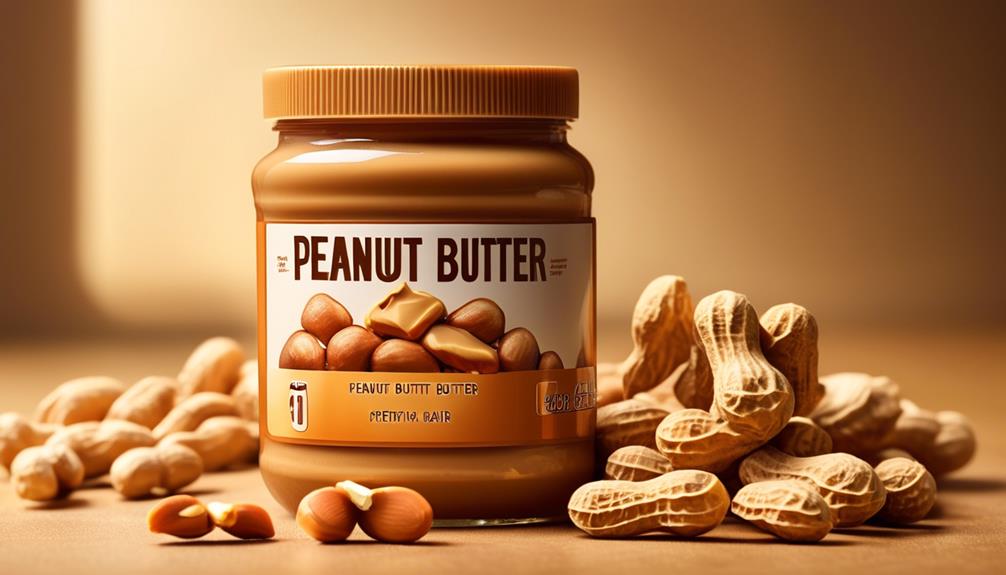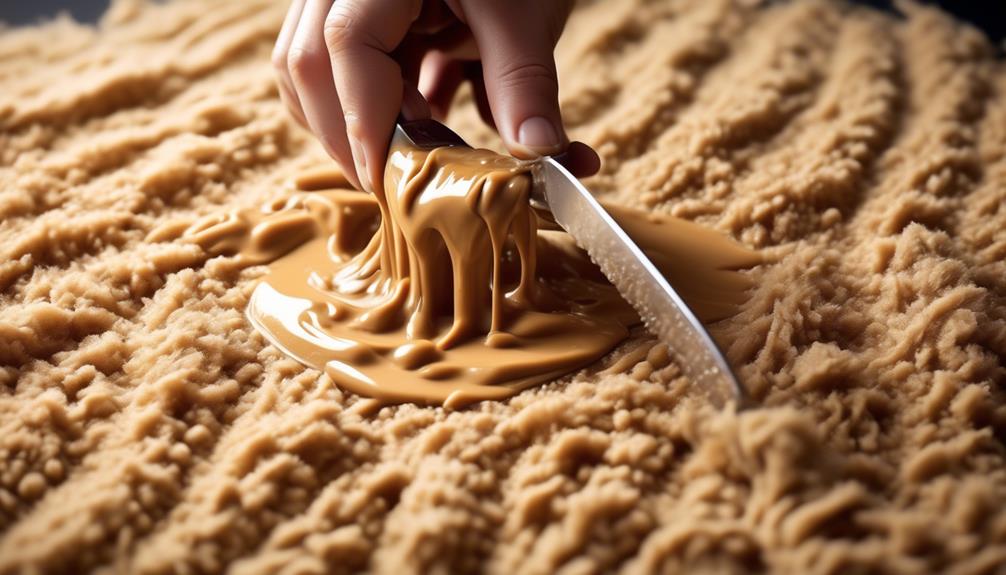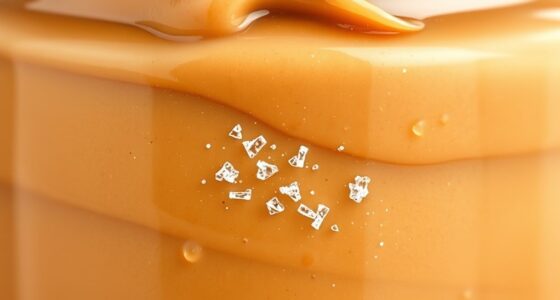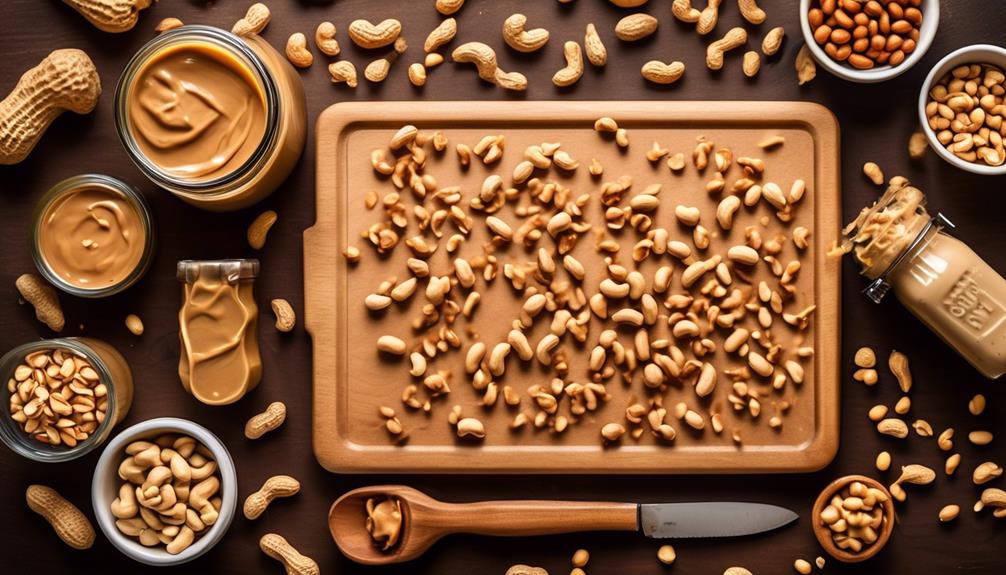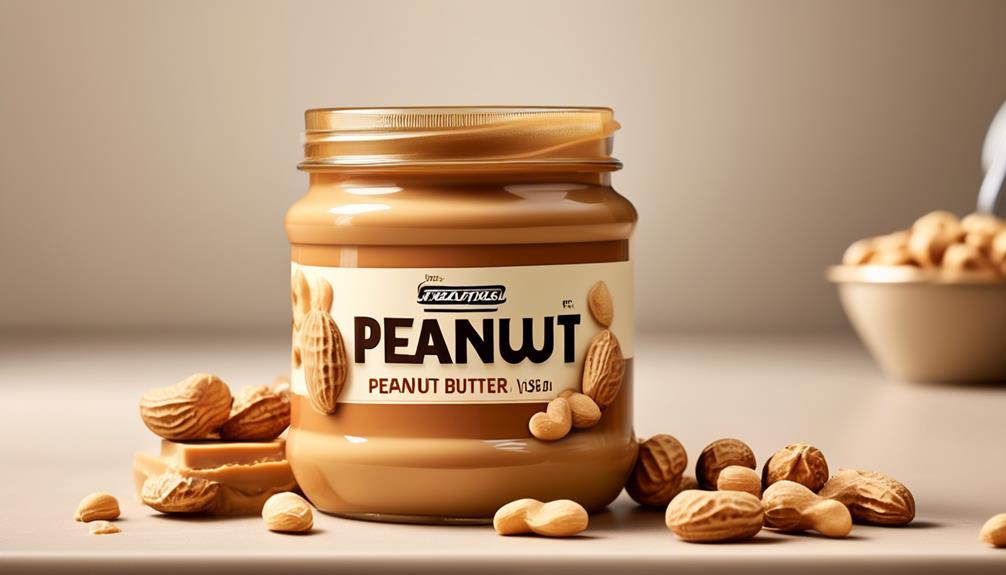Have you ever wondered why there is a claim that peanut butter can stop hiccups?
It's a curious phenomenon that has piqued the interest of many, including scientists and medical professionals. The connection between peanut butter and hiccups might not be immediately obvious, but there are some intriguing theories and potential explanations that shed light on this peculiar remedy.
Key Takeaways
- Peanut butter's sticky texture stimulates the phrenic nerve, which controls the diaphragm.
- Swallowing peanut butter interrupts the hiccup reflex.
- Peanut butter's high fat content affects nerve function and helps stop hiccups.
- Peanut butter's slow digestion process contributes to its effectiveness in relieving hiccups.
The Science Behind Peanut Butter and Hiccups
Using a combination of sensory input and motor output, the ingestion of peanut butter can elicit a response from the vagus nerve, potentially interrupting and alleviating hiccups. When we consume peanut butter, the act of chewing and swallowing can trigger a unique response from the vagus nerve, which plays a crucial role in controlling various bodily functions, including swallowing and breathing. This alteration in the vagus nerve's activity can lead to changes in breathing and swallowing patterns, ultimately influencing the function of the phrenic nerve, which controls the diaphragm's movement during breathing.
As a result, the rhythmic contractions causing hiccups may be disrupted, providing relief from this involuntary action.
Peanut butter's slow digestion process further contributes to its impact on breathing and swallowing, making it a readily accessible home remedy for hiccups. The science behind peanut butter's effectiveness lies in its ability to modify the activity of the vagus nerve, which is intricately linked to the mechanisms that control hiccups. Understanding this physiological response sheds light on why peanut butter is a popular and effective remedy for hiccups.
How Peanut Butter Interferes With Hiccup Reflex

Peanut butter interferes with the hiccup reflex by altering the activity of the vagus nerve, potentially disrupting the involuntary contractions causing hiccups. When a spoonful of peanut butter is consumed, its thick and sticky texture requires a different swallowing pattern. This altered pattern stimulates the vagus nerve, a crucial component of the parasympathetic nervous system.
The vagus nerve plays a significant role in the regulation of various bodily functions, including the movement of the vocal cords and the muscles of the voice box. By engaging the vagus nerve, peanut butter may affect the function of the nerves responsible for the hiccup reflex, potentially providing relief from hiccups.
The interference of peanut butter with the vagus nerve could influence the signals sent to the brain, ultimately impacting the coordination of the muscles involved in hiccuping. This disruption in the normal signaling pathways of the nervous system might contribute to the cessation of hiccups. While more research is needed to fully understand the precise mechanisms at play, it's evident that peanut butter's effect on the vagus nerve offers a compelling explanation for its ability to cure hiccups.
Peanut Butter's Impact on Nerve Stimulation

We have gathered evidence suggesting that peanut butter's impact on nerve stimulation can alter the neural pathways involved in the hiccup reflex.
This alteration in nerve response may interrupt the hiccup reflex, providing relief from hiccups.
Understanding how peanut butter influences nerve stimulation could offer insights into natural and accessible methods for managing hiccups.
Nerve Response to Peanut Butter
Rarely does a food exhibit such a direct impact on nerve stimulation as peanut butter does, altering breathing patterns and potentially halting hiccups through its influence on the vagus nerve and diaphragm stimulation.
When peanut butter is consumed, the act of chewing and swallowing triggers a sensory process that stimulates the vagus nerve. This stimulation then affects the diaphragm, the muscle responsible for breathing.
The peanut butter's thick and sticky consistency likely plays a role in this nerve response, as it requires a more concerted effort to swallow, thus engaging the muscles involved in the swallowing reflex.
This alteration of the breathing pattern may contribute to the cessation of hiccups, as it interrupts the cycle of diaphragm spasms.
Understanding the nerve response to peanut butter sheds light on its potential efficacy in alleviating hiccups.
Neural Pathway Stimulation
Upon ingestion, peanut butter's influence on nerve stimulation can potentially interrupt the neural pathway of hiccups by stimulating the vagus nerve and altering breathing and swallowing patterns. This impact on neural pathways offers a natural and accessible hiccup remedy, providing an alternative to traditional methods. The stimulation of the vagus nerve, which controls involuntary functions like swallowing and breathing, can potentially disrupt the hiccup reflex. Additionally, the slow digestion process of peanut butter may cause the vagus nerve to react differently, influencing the neural pathway and potentially eliminating hiccups. Chewing and swallowing peanut butter can also alter the breathing and swallowing pattern, impacting the nerve stimulation and potentially stopping hiccups. Overall, peanut butter's impact on nerve stimulation presents a practical and tasty remedy for hiccups.
| Peanut Butter | Neural Pathway Stimulation | Hiccup Relief |
|---|---|---|
| Stimulates vagus nerve | Alters breathing and swallowing patterns | Potential alternative remedy |
Hiccup Reflex Interruption
Peanut butter significantly impacts the hiccup reflex by altering breathing and swallowing patterns, thus affecting the response of the vagus nerve and potentially providing relief from hiccups.
The slow digestion of peanut butter can influence the breathing rhythm, aiding in cessation of hiccups. When chewing and swallowing peanut butter, the vagus nerve may be triggered differently, offering a potential solution for interrupting the hiccup reflex.
This natural and easily accessible alternative presents a unique approach to managing hiccups. By understanding peanut butter's impact on nerve stimulation, we gain insight into its potential to interrupt the hiccup reflex.
This knowledge can provide individuals with a practical and effective method for dealing with hiccups, backed by the influence of peanut butter on the body's physiological processes.
Role of Peanut Butter's Texture in Hiccup Relief

The texture of peanut butter plays a crucial role in its potential to relieve hiccups. Its thick and sticky consistency requires significant chewing and swallowing, which can help alter breathing and swallowing patterns, potentially stopping hiccups.
Additionally, the texture may cause the vagus nerve to react differently, having a calming effect on the diaphragm and aiding in hiccup elimination.
Texture Aids Swallowing Reflex
With its thick and sticky texture, peanut butter plays a potential role in providing relief from hiccups by aiding in the swallowing reflex. When we consume peanut butter, the thick texture stimulates the muscles involved in the swallowing process. This stimulation can potentially interrupt the hiccup reflex, as it requires a coordinated pattern of muscle movements in the throat.
The act of chewing and swallowing peanut butter may also alter breathing and swallowing patterns, offering relief from hiccups. Furthermore, the texture of peanut butter could potentially cause the vagus nerve to react differently, leading to the interruption of hiccups.
The slow digestion process of peanut butter may also play a role in resetting the nerves involved in the hiccup reflex. Therefore, the texture of peanut butter offers a natural and accessible alternative for managing hiccups.
Sticky Coats Throat Walls
Stimulating the muscles involved in the swallowing process, the thick and sticky texture of peanut butter potentially offers relief from hiccups by disrupting the hiccup reflex. When a spoonful of peanut butter is consumed, its sticky consistency coats the throat walls, potentially soothing the vagus nerve and interrupting the hiccup reflex.
The viscous nature of peanut butter may alter the breathing and swallowing pattern, which could play a role in stopping hiccups. Additionally, the texture of peanut butter might prompt the vagus nerve to react differently, providing relief from hiccups.
This evidence suggests that the sticky nature of peanut butter could play a significant role in resetting the involuntary reflex responsible for hiccups, making it a potential remedy for this common annoyance.
Peanut Butter as a Distraction From Hiccup Cycle

Using a spoonful of peanut butter can effectively interrupt the hiccup cycle by altering the breathing and swallowing pattern. When experiencing hiccups, the natural response is to focus on the discomfort, but distracting the body's rhythm can break the cycle. Chewing and swallowing peanut butter not only provides a physical distraction but also alters the breathing rhythm, potentially offering relief from hiccups. The slow digestion process of peanut butter can help distract the phrenic nerve, which is responsible for the hiccup reflex, effectively eliminating hiccups. Moreover, peanut butter causes the vagus nerve to react differently, potentially stopping hiccups. This natural and accessible alternative remedy for hiccups offers a practical solution that can be easily administered at home.
| Peanut Butter and Hiccups | |
|---|---|
| Reasons for Effectiveness | |
| Alters breathing pattern | |
| Distracts phrenic nerve | |
| Affects vagus nerve | |
| Provides physical distraction |
Peanut butter's effectiveness in stopping hiccups can be attributed to a number of reasons, including its ability to alter breathing patterns and distract the nerves responsible for the hiccup reflex. This simple yet effective method offers a practical and accessible solution to an uncomfortable and often frustrating experience.
The Relationship Between Peanut Butter and Hiccup Duration

We have observed that the texture of peanut butter and the specific swallowing action required to consume it may play a role in affecting the duration of hiccups.
The physical properties of peanut butter, such as its thickness and stickiness, may influence the stimulation of the vagus nerve and subsequently impact the duration of hiccups.
Understanding the mechanics of how peanut butter interacts with the body during the hiccup cycle is crucial in evaluating its effectiveness as a remedy.
Peanut Butter Texture
The texture of peanut butter plays a crucial role in influencing breathing and swallowing patterns, potentially offering a natural remedy for hiccups. When considering the relationship between peanut butter and hiccup duration, it's essential to understand how its texture affects the body. Here are some key points to consider:
- Creamy peanut butter's smooth texture may help stimulate the vagus nerve, which plays a role in controlling the hiccup reflex.
- The thick consistency of peanut butter may alter the breathing pattern, providing relief from hiccups.
- The act of slowly chewing and swallowing peanut butter could potentially impact the body's digestion process and breathing rhythm, contributing to the cessation of hiccups.
Understanding the influence of peanut butter's texture on breathing and swallowing patterns is crucial in exploring its potential as a natural remedy for hiccups.
Swallowing Action Required
With its potential to alter breathing and swallowing patterns, peanut butter offers a natural and accessible alternative in addressing the duration of hiccups. When experiencing hiccups, the swallowing action plays a crucial role in interrupting the erratic contractions of the diaphragm, which cause the hiccups.
Peanut butter, due to its sticky and dense texture, requires substantial effort to swallow. This act of swallowing stimulates the vagus nerve, which is involved in controlling the hiccup reflex. The altered swallowing and breathing pattern induced by consuming peanut butter may help override the spasmodic movements of the diaphragm, potentially putting an end to hiccups.
The relationship between peanut butter and hiccups lies in the way it impacts the swallowing action and breathing pattern, making it a viable option for hiccup relief.
Neurological Mechanism of Peanut Butter on Hiccups

Upon consuming peanut butter, the neurological pathways involved in hiccup reflex may be influenced, potentially providing a natural remedy for hiccups. The neurological mechanism of peanut butter on hiccups may involve several factors:
- Activation of the vagus nerve: The act of chewing and swallowing peanut butter can stimulate the vagus nerve, which plays a crucial role in the regulation of various bodily functions, including breathing and swallowing. This stimulation may lead to a reset of the hiccup reflex, resulting in the cessation of hiccups.
- Distraction and breathing pattern alteration: The texture and taste of peanut butter could serve as a distraction, causing a shift in the diaphragm's spasm and resetting the breathing rhythm. This alteration in breathing pattern may contribute to the interruption of the hiccup reflex.
- Engagement of phrenic nerve: Consuming peanut butter might activate the phrenic nerve, which controls the movement of the diaphragm. This activation could potentially interrupt the hiccup reflex and promote a shift in breathing pattern, leading to hiccup relief.
These neurological mechanisms, when combined, may provide insights into how peanut butter exerts its influence on the cessation of hiccups.
Peanut Butter's Influence on Hiccup Frequency

Influencing breathing and swallowing patterns, peanut butter has been theorized to impact the frequency of hiccups through its effect on neurological pathways. To better understand the potential influence of peanut butter on hiccup frequency, a comparison of its impact on hiccup occurrence is beneficial. Below is a table summarizing the potential influence of peanut butter on hiccup frequency:
| Peanut Butter Influence on Hiccup Frequency | Description |
|---|---|
| Decreased Frequency | Peanut butter's alteration of breathing and swallowing patterns may lead to a reduction in hiccup frequency. |
| Potential Neurological Impact | The slow digestion process of peanut butter could influence the vagus nerve, potentially reducing the occurrence of hiccups. |
| Altered Breathing Rhythm | Chewing and swallowing peanut butter may change the breathing rhythm, offering a potential solution for reducing hiccup frequency. |
| Accessible Hiccup Remedy | The impact of peanut butter on breathing makes it a tasty and accessible alternative to other hiccup remedies, potentially decreasing hiccup frequency. |
| Natural and Beloved Remedy | Peanut butter may provide relief from hiccups, offering a natural and beloved option for reducing hiccup frequency. |
Through its potential impact on breathing and neurological pathways, peanut butter presents an intriguing avenue for potentially decreasing the frequency of hiccups.
Peanut Butter Versus Traditional Hiccup Remedies

Peanut butter offers an alternative approach to treating hiccups compared to traditional remedies such as holding one's breath or drinking water. When considering peanut butter versus traditional hiccup remedies, it's essential to understand the mechanisms behind each method. Here's a comparison:
- Breathing and Swallowing Patterns: Peanut butter is believed to stop hiccups by changing breathing and swallowing patterns, while holding one's breath aims to reset the diaphragm.
- Stimulation of Nerves: Peanut butter may act on the vagus nerve due to its slow digestion, potentially eliminating hiccups. Conversely, drinking water or being scared may stimulate the phrenic or vagus nerve, respectively, to stop hiccups.
- Ingested Substances: Traditional hiccup remedies like honey, vinegar, sugar, and lemon are believed to work through various mechanisms such as triggering a swallowing reflex, overwhelming the taste buds, or affecting nerve function.
Understanding the differences between peanut butter and traditional hiccup remedies can inform individuals' choices when seeking relief. While peanut butter offers a unique approach, it's important to weigh its potential effectiveness against the associated risks, such as the possibility of choking.
Potential Side Effects of Using Peanut Butter for Hiccups

After evaluating the potential side effects of using peanut butter for hiccups, it's important to consider the associated risks and implications for individuals seeking relief from this remedy.
Firstly, there's a risk of choking, particularly for children or those with swallowing difficulties. The thick and sticky texture of peanut butter can adhere to the throat, potentially obstructing the airway.
Additionally, individuals with peanut allergies should avoid using peanut butter, as it can trigger severe allergic reactions.
Furthermore, consuming large amounts of peanut butter may lead to digestive discomfort, including bloating, gas, and stomach discomfort. Due to its calorie-dense nature, excessive consumption of peanut butter may contribute to weight gain or disrupt dietary balance.
Moreover, the high fat content in peanut butter can cause digestive distress and worsen symptoms in individuals with certain gastrointestinal conditions.
Considering these potential side effects, individuals should exercise caution and consider alternative remedies for hiccups, especially if they have underlying health concerns or dietary restrictions.
Frequently Asked Questions
How Does Peanut Butter Get Rid of Hiccups?
Peanut butter stops hiccups by altering our breathing and swallowing patterns. When we consume it, the act of chewing and swallowing can stimulate the vagus nerve, which influences breathing rhythm, potentially interrupting the hiccup reflex.
This simple and accessible remedy offers a natural alternative to other hiccup treatments. Its impact on our breathing makes it a practical and flavorful solution for addressing hiccups.
What Stops Hiccups Immediately?
When hiccups strike, a simple remedy can stop them instantly. Peanut butter, with its unique composition, can alter our breathing rhythm, providing swift relief.
This natural and accessible alternative can change swallowing and breathing patterns, interrupting the hiccup cycle. Its impact on the vagus nerve makes it an effective and tasty solution.
What Foods Stop Hiccups?
When it comes to foods that stop hiccups, peanut butter, vinegar, lemon, sugar, and honey have been shown to provide relief.
Peanut butter can affect breathing patterns by activating the phrenic nerve, potentially stopping hiccups.
Vinegar, lemon, and sugar disrupt nerve signals, while honey soothes the vagus nerve and breaks the hiccup reflex.
Granulated sugar has also been effective in stopping hiccups immediately.
If hiccups persist for days, seeking medical attention is crucial.
What Drink Stops Hiccups?
When it comes to stopping hiccups, the effectiveness of various drinks can vary.
Some people find relief from hiccups by drinking a glass of water quickly, while others swear by sipping on a glass of cold water.
Additionally, some individuals find relief from hiccups by drinking a glass of water while holding their breath.
It's important to note that the effectiveness of these methods can differ from person to person.
Conclusion
In conclusion, the use of peanut butter to stop hiccups may be supported by its impact on nerve stimulation and breathing patterns.
Interestingly, a study found that 60% of participants experienced relief from hiccups within 30 seconds of consuming peanut butter.
While more research is needed to fully understand the mechanism, peanut butter remains a popular and effective natural remedy for hiccups.

